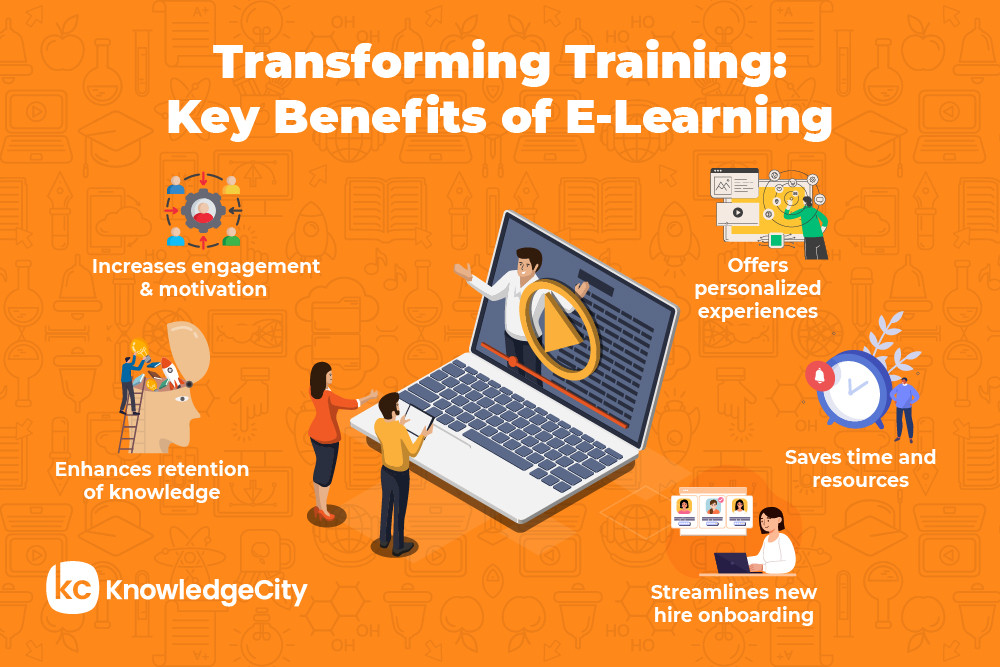HR professionals are constantly seeking innovative ways to equip employees with the skills they need to succeed. This is where eLearning can be particularly effective. In fact, 90% of companies provide some form of online learning to their employees. But, while eLearning offers a flexible and engaging solution, crafting compelling content can be a challenge.
This guide explores how to curate effective eLearning content that provides HR professionals with a strategic framework for developing rich learning experiences that resonate with their workforce.

Benefits of eLearning
Optimizing your eLearning content involves tailoring educational materials to meet your employees’ needs. This ensures they get the most out of their training.
Here are some of the benefits of eLearning:
- Increases Engagement and Motivation: Optimized eLearning content is designed to capture and maintain learners’ attention. By choosing relevant, interactive, and engaging content, you can increase employee motivation and encourage active participation.
- Saves Time and Resources: With optimized eLearning content, employees learn at their own pace and in their own time. Corporate eLearning takes 40–60% less time than traditional classroom training, saving valuable time and resources for both the organization and employees. Optimized content is easy to update or reuse, making it cost-effective for employee development.
- Personalized Learning Experience: Switching to eLearning allows for more personalized learning that caters to employees’ diverse learning styles and needs.
- Enhances Knowledge Retention: Employees are more likely to retain information when learning content is engaging and relevant. Optimized content often includes interactive elements that help reinforce knowledge through practice and application.
- Streamlines Onboarding Process: Organizations can use eLearning content to significantly streamline the onboarding process. New hires can quickly learn company policies, procedures, and their specific job roles, reducing the time it takes for them to become productive members of the team.
Types of eLearning Content
- Bite-Sized Learning Modules: Bite-sized learning modules are brief, focused content segments designed for quick learning. They’re easy to grasp, allowing employees to learn even with busy schedules. These modules can include videos, interactive quizzes, and mini-games to keep learners engaged.
- Gamification: Gamification brings game elements into nongame settings, like education. It’s a popular way to make learning more engaging. By adding features such as leaderboards, points, and badges, employees are motivated to complete training tasks.
- Scenario-Based Learning: Scenario-based learning offers real-life situations and challenges for employees to apply in their jobs. It encourages critical thinking and decision-making skills.
- Interactive Ebooks and Guides: Digital books and guides with interactive elements such as embedded videos, quizzes, and infographics offer an immersive learning experience that goes beyond traditional course study.
- Microlearning Platforms: Microlearning platforms offer small, specific pieces of content that target particular skills or knowledge areas. These platforms are ideal for just-in-time learning and for reinforcing concepts.
Who Is Responsible for eLearning Content Optimization?
Depending on the organization’s size and structure, different individuals or teams may be responsible for learning content optimization. In smaller organizations, HR professionals might take on this role, while larger organizations often have dedicated teams for learning and employee development.
HR professionals and training coordinators are at the forefront of eLearning content optimization in many organizations. They are responsible for aligning content with business goals so that it meets the needs of all employees.
In larger organizations, specialized eLearning development teams create and manage content. These teams include instructional designers, graphic designers, and multimedia specialists.
Instructional designers focus on creating effective and engaging educational content, using learning theories and design principles.
Subject matter experts (SMEs) make sure content is accurate and relevant. They also work with instructional designers to make sure it reflects industry best practices.
Technical support teams ensure learning platforms and tools work properly and integrate with other HR systems.
Regardless of who’s responsible, effective content curation and delivery demands knowledgeable people who are familiar with the organization’s learning needs.
Tools for eLearning Content Optimization
Various tools and platforms are available to help HR professionals optimize learning content. These tools can help with content curation, organization, and delivery. Here are some popular tools to consider:
- Learning Management Systems (LMS): An LMS software application allows organizations to manage, deliver, and track learning content. It provides a centralized platform for organizing, assigning, and monitoring employee learning and development.
- Analytics and Reporting Tools: Analytics tools provide insights into how employees interact with learning content. They help identify trends, gaps in learning, and areas for improvement. Examples include Google Analytics and Tableau.
- Collaboration and Communication Tools: These tools facilitate social learning and communication among learners. They support forums, chat functions, and social media integration. Slack and Microsoft Teams are examples of such tools.
- Accessibility Tools: Accessibility tools ensure that learning content can be used easily by people with disabilities. These include screen readers, captioning services, and keyboard navigation support.
Best Practices for eLearning Content Optimization
Now that we understand the importance of learning content optimization, let’s explore the best practices for curating effective learning content.
- Understand Your Audience: Start by understanding your audience. Identify their job roles, learning preferences, and skill requirements. Conducting needs assessments and employee surveys can aid in gathering this information. Understanding your audience helps in selecting relevant and valuable content.
- Choose High-Quality Content: Prioritize high-quality materials when selecting eLearning content. Ensure accuracy, currency, and visual appeal. Verify the credibility of content sources and seek approval from subject matter experts.
- Align Content with Organizational Goals: Ensure that the eLearning content you curate aligns with your organization’s broader goals and objectives. This alignment guarantees that the skills and knowledge discussed remain relevant to the business’s strategic direction.
- Utilize Multiple Formats: Diversify eLearning content formats—including videos, podcasts, quizzes, and games—to cater to various learning styles. Consider any audience accessibility needs as well.
- Encourage Social Learning: Social learning can enhance the learning experience by allowing employees to learn from each other. Incorporate features that enable collaboration, discussion, and knowledge sharing among peers.
- Measure and Analyze Learning Outcomes: Use analytics tools to track the effectiveness of eLearning content. Monitor completion rates, quiz scores, and other metrics to understand how well employees absorb the material, then use this data to make informed adjustments.
- Offer Continuous Learning Opportunities: Don’t make eLearning a one-time event. Provide ongoing learning opportunities that allow employees to continuously develop their skills and knowledge.
Curating eLearning Content with KnowledgeCity
Optimizing eLearning content is essential for effective employee training and development. By understanding your audience, choosing high-quality content, utilizing multiple formats, and employing the right tools, you can create an effective learning program that benefits your employees and organization.
By actively curating eLearning content, HR professionals can cultivate a culture of learning within the organization that drives performance, innovation, and competitive advantage.
Subscribe to Our Newsletter
Join 80,000+ Fellow HR Professionals. Get expert recruiting and training tips straight
to your inbox, and become a better HR manager.

 KnowledgeCity
KnowledgeCity 










